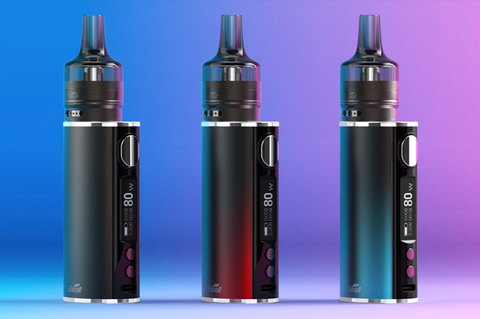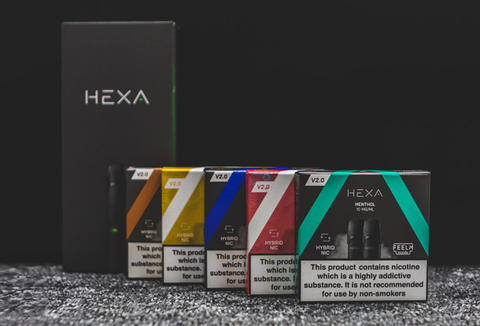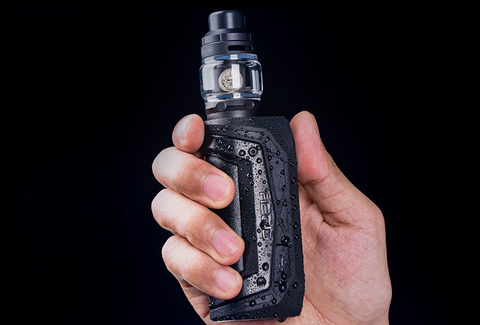9 Vape Trends for 2021
It can be hard to predict trends in vaping.
In fact, at our office (pre-covid!) we used to say that all we can predict is that, at some point, something we can’t foresee will completely turn vaping on its head. That, at least, has turned out to be true several times.
Still, by monitoring current trends, talking to manufacturers and referencing our 2021 expert predictions post, we can come up with some educated guesses…
1. Pod systems – but not as you know them…

When pods first launched there were clear distinctions between them and mods.
(For anyone not familiar with the vaping scene, pods systems are/were smaller devices with cartridges that clipped into a device. Mod systems came with a tank that had to be screwed in, had more power and more advanced functions.)
Nowadays, however, the two are increasingly starting to merge into one, and we’ve even had a couple of debates at work about whether we should classify a kit as a pod or a mod system.
We’ve even had the introduction of pod tanks, such as the GTL pod tank, which (sometimes with the help of an adaptor) are cross-compatible with both pod and mod devices.
These ‘pod mod’ devices are growing in popularity, perhaps because they are so flexible, with many systems able to deliver both a Mouth-to-Lung and a Direct-Lung vape. They’re often more compact than a mod, but can still deliver a great power range and battery life, with some pod mods using one or more external batteries.
Small wonder that Vaporesso told us that “2021 will be the year of the pod mod.”
2. Closed v. open systems: Which will win?

One trend in recent years has been the increasing popularity of Big Tobacco devices, which are often closed pod systems.
In contrast, there are very few successful closed pod systems in the independent industry (the Hexa V.2 being one).
That’s not surprising, as a closed system:
·is more expensive to run
·limits the number of flavours you can vape
·is best suited for people who have problems with eyesight or mobility.
Most people who go into a vape shop, and have the pros and cons explained, will choose an open system.
Closed pod systems will continue to be an entry point for more vapers, especially those who start with a device from a supermarket or convenience store or who prefer to stick with a tobacco brand.
However, as existing vapers become aware of the different options, see what other people are vaping, and as coils become ever easier to change, I think we will see more vapers changing to open systems.
This comes with a caveat, though, as two things could put a spanner in the works.
The first is the closure of vape shops during Covid, meaning fewer smokers have access to expert advice from experienced vape shop staff.
The second would be relaxing of advertising rules, leading to huge marketing campaigns by well-resourced tobacco companies determined to regain control of the nicotine market and to sell closed pods systems which offer them better margins and more control.
3. Tougher, more resilient devices
The days when you could drop your vape and it instantly breaks are coming to an end.
Geekvape has led the way with indestructible devices, creating kits such as the Aegis Max Zeus, which is waterproof, shockproof and dust resistant.
Their success has meant that other vape companies have quickly followed, and there could be an arms race to build the toughest, most water-proof device, with Geekvape in particular keen to keep its current lead. Expect to see lots of videos of vapes being dropped in water, taken out and then used.
Most people probably won’t notice the difference, but these tough devices will be a boon for people like construction workers and those who are, like me, just plain clumsy.
4. Breaking down barriers

Most starter kits are very easy to use already, but things will get even easier.
There’s a clear focus, for example, on making vape coils easier to change and devices easier to fill. In 2020 we’ve seen pop out coils and self-cleaning technology. This could also contribute to open systems winning over closed systems.
We’ll also see attempts to make high wattage vaping more accessible.
Vaporesso has made great strides in this area – creating devices which can be used with advanced functions but also include modes that make them easier to use for less experienced vapers.
Advances like these will make cloud vaping and temperature control vaping accessible to more users.
5. A greener future?

We’ve seen little focus on the environment in the past when it comes to vaping, but I think there will be more emphasis on this in the future.
Innokin are leading the way here, with biodegradable filters in their new FLTR kit, introducing the use of recyclable packaging and calling for battery recycling stations, but other manufacturers will follow.
There does seem to be a trend towards disposable e-cigarettes. This trend is taking off in the USA, but where the USA goes the UK often follows. While this can be great for smokers who want to try vaping without making too much of a commitment, it’s a concerning development from an environmental perspective.
One continued problem is plastic waste. Vape companies are limited by regulations here, but I am hopeful that restrictions on bottle sizes will be lifted in the UK, allowing larger bottles leading to smaller overall plastic use.
6. Power isn’t everything

For years there has been competition to see how much power you can squeeze out of a vape mod. But there’s a limit to how much power you can get out of a mod before you simply burn the coil.
For example, you’ll quite often see a mod kit which can output 200 watts or more paired with coils that can be used with a maximum wattage of 70 watts.
There will always be a niche group of vapers who build their own coils or simply like having a powerful device, but most vapers don’t need any more than 80 watts of power. We’re starting to see that reflected in vape devices now, with more coming out with a more limited wattage range (typically 5-80 W instead of 1-250 W).
7. Battery evolution

For years battery life has been improving while, at the same time, charging time has been going down. Even smaller devices are boasting an increasingly large capacity, and there should soon be a time when MTL vapers with the right device can go days or more without needing to recharge their battery.
8. E-Liquid: Brand dominance?

It wasn’t long ago that a new brand seemed to be launched every few days. However, I think that the time when a brand could come from nowhere and launch a seriously successful e-liquid range without spending serious money has gone.
Instead, we are increasingly seeing established companies launching new flavours in their existing range, as well as new sub-brands. Think of Zap Juice launching Aisu, Aisu Yogorutu, Mokasmu and Z Fuel, for example. There may be a handful of new brands that break through, but they will be few and far between.
9. Youth vaping – and futile attempts to appease the anti-vaping crowd

As the anti-vaping crowd continues to manipulate science and data to pretend youth vaping is a problem (an effort which could lead to the resurgence of youth smoking), some manufacturers will respond with efforts to make their device childproof. These devices might, for example, integrate with smartphones via Bluetooth and require vapers to pass an age verification test.
This is unlikely to apply to all devices, but if it did, I suspect the small number of teenagers who vape regularly will respond by putting an equal amount of effort into getting around this technology – those who can’t will probably revert to smoking.
Anti-vape campaigners will not be appeased and will continue with their efforts to ban and demonise vaping, in the process making vaping more attractive to children, causing endless problems for adult vapers and helping to protect tobacco sales.
Finally
Vape trends are difficult to predict, but hey, it’s fun!
